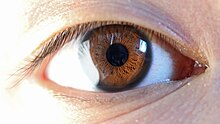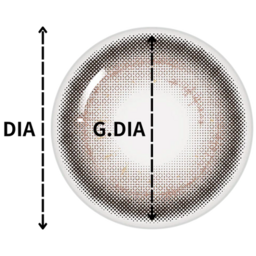Circle contact lens

A circle contact lens, also known as a big eye contact lens and circle lens, is a cosmetic (non-corrective and decorative) contact lens that makes the eye's iris appear larger. It has become a trend throughout East, South and Southeast Asia and is largely produced in Japan, South Korea and China.
Design
[edit]Circle lenses make one's eyes appear larger and come in a variety of colors and effects. They have been around since 2004 and are very popular in countries such as South Korea, Japan, Taiwan and China.

The diameter of regular contact lenses that are sold in the United States are on average 14–16 mm. Similar to the diameter of regular contact lenses, circle lenses have no more than 15 mm diameter since larger sizes would be harmful to the eyes at daily wear. When the diameter of the circle lens is described as 16 mm or 18 mm, it is only the provided visual effect of the circle lens.[1] The difference between the two types of lenses is that circle lenses are tinted not only in areas that cover the iris of the eye, but also prominently in the extra-wide outer rim of the lens. The result is the appearance of a bigger, wider iris with a limbal ring, creating an illusion of large eyes.[2]
The optical zone in the middle is transparent and it is large enough to provide clear vision. When big eye contacts first launched, they were only available in yearly disposable format, but as the trend spread, these lenses are now available as dailies, biweeklies and monthlies.[3] The lenses are popular among teenagers and young adults. Many people consider circle lenses to be a fashion accessory rather than a medical device. In Hong Kong, many young female models wear them as popular fashion icons.
Graphic Diameters (G.DIA)
[edit]
The Graphic Diameter (G.DIA) of colored contact lenses refers to the diameter of the tinted area on the lens, specifically the colored section that covers the eye. Unlike the total Diameter (DIA) of the contact lens, the Graphic Diameters (G.DIA) only measures the colored portion, and it is typically expressed in millimeters (mm).
The size of this tinted area influences the overall visual appearance, particularly the proportion between the pupil and iris. A larger G.DIA can make the eyes look bigger and more noticeable, while a smaller one tends to create a more natural look.
Generally, the G.DIA of colored lenses ranges from 12.0mm to 13.8mm, depending on the lens design and the intended visual effect. Selecting the appropriate G.DIA depends on personal preferences, such as whether you want your eyes to appear larger or for the color to stand out more.[4]
Popularity
[edit]In Asia, circle contact lenses can be bought from many online stores and are imported from manufacturing countries such as South Korea to nations such as Thailand, China, Malaysia, Japan, Nepal, Sri Lanka, Singapore, Vietnam, and Taiwan.[5][6][7] They can be purchased without a prescription (0.00 or plano) or with prescription.[2] Their legality in the West varies with the local laws, and in the United States they are currently classified as a medical device and are not legal for sale without a valid prescription.[8]
Risks
[edit]A meta-analysis reported that cosmetically tinted lenses appear to be safe when properly prescribed by an eye care professional and when used correctly.[9]
Decorative soft contact lens must be fitted appropriately, as tinted soft contact lenses may reduce vision by temporarily increasing the number of high-order aberrations under bright-light and low-light conditions, as the center of tinted lenses does not always coincide with the center of the cornea, and thus decorative soft contact lenses must be fitted appropriately.[10] Indeed, concerns with these lenses in the United States arise from people buying lenses without consulting their optometrists, which could result in lenses that do not fit the individual's eyes properly.[11]
Legality
[edit]United States
[edit]In the United States decorative, non-corrective contact lenses are considered medical devices by the Food and Drug Administration (FDA) and sale and marketing of such devices require market clearance by the FDA and a valid prescription from a medical professional.[12] Devices that have not been cleared by the FDA may be subject to seizure by US Customs.
Korean contact lens companies Geo Medical Inc. and Migwang Contact Lens[13] (operating under the brand name Clearlab in the US) have been approved by the FDA for sale in the United States. Circle lenses manufactured in Korea are under the approval and guidelines of the Ministry of Food and Drug Safety. Acuvue, the contact lens brand from Johnson & Johnson Vision, has a line of prescription daily disposable color contact lenses marketed under the name "1-Day Acuvue Define" available in the United States as well as other countries.[14]
See also
[edit]References
[edit]- ^ "The Official Circle Lens Thread". Gaia Online.
- ^ a b "Blinded by an Urge for Beauty". Xinhua News. 2010-07-14. Archived from the original on July 18, 2010. Retrieved 2010-07-17.
- ^ "Why Choose Big Eye Contact Lenses over Regular Colored Contacts?". Archived from the original on 2013-12-13. Retrieved 2013-12-10.
- ^ "How do I choose the right color contact lenses diameter?". Lens Diary. Retrieved 2024-09-15.
- ^ "EyeCandy's Circle Lens Compendium".
- ^ "Untitled Document". Archived from the original on 2017-08-26.
- ^ "Don't be blind to "big eye' drawbacks, doctors advise". 2013-08-08. Archived from the original on April 22, 2014.
- ^ "What Big Eyes You Have, Dear, but Are Those Contacts Risky?". The New York Times. 2010-07-03. Retrieved 2011-07-21.
- ^ Rah MJ, Schafer J, Zhang L, Chan O, Roy L, Barr JT (2013). "A meta-analysis of studies on cosmetically tinted soft contact lenses". Clinical Ophthalmology. 7: 2037–42. doi:10.2147/OPTH.S51600. PMC 3798236. PMID 24143071.
- ^ Koh, S; Higashiura, R; Maeda, N (September 2016). "Overview of Objective Methods for Assessing Dynamic Changes in Optical Quality". Eye & Contact Lens (Review). 42 (5): 333–8. doi:10.1097/ICL.0000000000000232. PMID 26783977. S2CID 32364945.
- ^ "Lady Gaga's Dangerous Trend". CBS News. 2010-07-06. Retrieved 2010-07-06.
- ^ "Decorative, Non-corrective Contact Lenses". U.S. Food and Drug Administration. 2006-11-24. Retrieved 2012-01-11.
- ^ "510(k) Premarket Notification". FDA.gov.
- ^ "Acuvue contact lenses". Retrieved 2024-11-07.
